Alright, I did some great work towards the brute forcer today.
Put simply, I've been doing testing using a specific sequence from the old TAS, and I was able to successfully output this:
{"I","L","Z","L","L","O","O","Z","T","J"}: 28 ({7,2,0,0,5,3,0,5,4,2})
{"I","L","Z","L","L","O","Z","O","T","J"}: 26 ({7,2,0,0,5,3,3,0,2,4})
{"I","L","Z","L","L","O","Z","T","O","J"}: 25 ({7,2,0,0,5,3,3,1,3,1})
{"I","L","Z","L","L","Z","O","O","T","J"}: 35 ({7,2,0,0,5,2,1,14,3,1})
{"I","L","Z","L","L","Z","O","T","O","J"}: 25 ({7,2,0,0,5,2,1,6,1,1})
{"I","L","Z","L","Z","L","O","T","O","J"}: 26 ({7,2,0,0,0,5,2,8,1,1})
{"L","I","L","L","O","Z","O","Z","T","J"}: 35 ({0,5,1,12,11,2,0,1,2,1})
{"L","I","L","L","O","Z","Z","O","T","J"}: 43 ({0,5,1,12,11,2,1,8,0,3})
{"L","I","L","L","O","Z","Z","T","O","J"}: 38 ({0,5,1,12,11,2,1,0,2,4})
{"L","I","L","L","Z","Z","O","O","T","J"}: 45 ({0,5,1,12,2,11,6,6,1,1})
{"L","I","L","L","Z","Z","O","T","O","J"}: 41 ({0,5,1,12,2,11,6,0,4,0})
{"L","I","L","L","Z","Z","T","O","O","J"}: 59 ({0,5,1,12,2,11,9,1,13,5})
{"L","I","L","Z","L","O","O","Z","T","J"}: 29 ({0,5,1,2,3,7,0,5,4,2})
{"L","I","L","Z","L","O","Z","O","T","J"}: 27 ({0,5,1,2,3,7,3,0,2,4})
{"L","I","L","Z","L","O","Z","T","O","J"}: 26 ({0,5,1,2,3,7,3,1,3,1})
{"L","I","L","Z","L","Z","O","O","T","J"}: 36 ({0,5,1,2,3,6,1,14,3,1})
{"L","I","L","Z","L","Z","O","T","O","J"}: 26 ({0,5,1,2,3,6,1,6,1,1})
{"L","I","Z","L","L","O","O","Z","T","J"}: 27 ({0,5,3,0,5,3,0,5,4,2})
{"L","I","Z","L","L","O","Z","O","T","J"}: 25 ({0,5,3,0,5,3,3,0,2,4})
{"L","I","Z","L","L","O","Z","T","O","J"}: 24 ({0,5,3,0,5,3,3,1,3,1})
{"L","I","Z","L","L","Z","O","O","T","J"}: 34 ({0,5,3,0,5,2,1,14,3,1})
{"L","I","Z","L","L","Z","O","T","O","J"}: 24 ({0,5,3,0,5,2,1,6,1,1})
{"L","I","Z","L","Z","L","O","T","O","J"}: 25 ({0,5,3,0,0,5,2,8,1,1})
{"L","Z","I","Z","L","L","O","O","T","J"}: 36 ({0,0,2,0,2,14,3,11,3,1})
{"L","Z","I","Z","L","L","O","T","O","J"}: 26 ({0,0,2,0,2,14,3,3,1,1})
{"L","Z","I","Z","L","T","L","O","O","J"}: 10 ({0,0,2,0,2,0,1,1,2,2})
I had an upper limit of max 15 frames wait, which is why not every permutation is here. That last piece order, with only 10 frames of delay, is indeed the one used in the old TAS, and the delay numbers seem mostly accurate (the last 2 should be a 1? I'll have to look into that...) (edit: I gave that O a 23 frame count instead of 24. it's perfect now!)
So, I have very high hopes for the future. I'm worried there's something more to the RNG than I have, since the old TAS ends up desyncing on today's BizHawk? But we'll see.
Right now turning your incredible work into proper data form will be a big timesink. And I'm still unsure if I should try to code a way to do the inputs automatically. It'd probably save time in the long run...




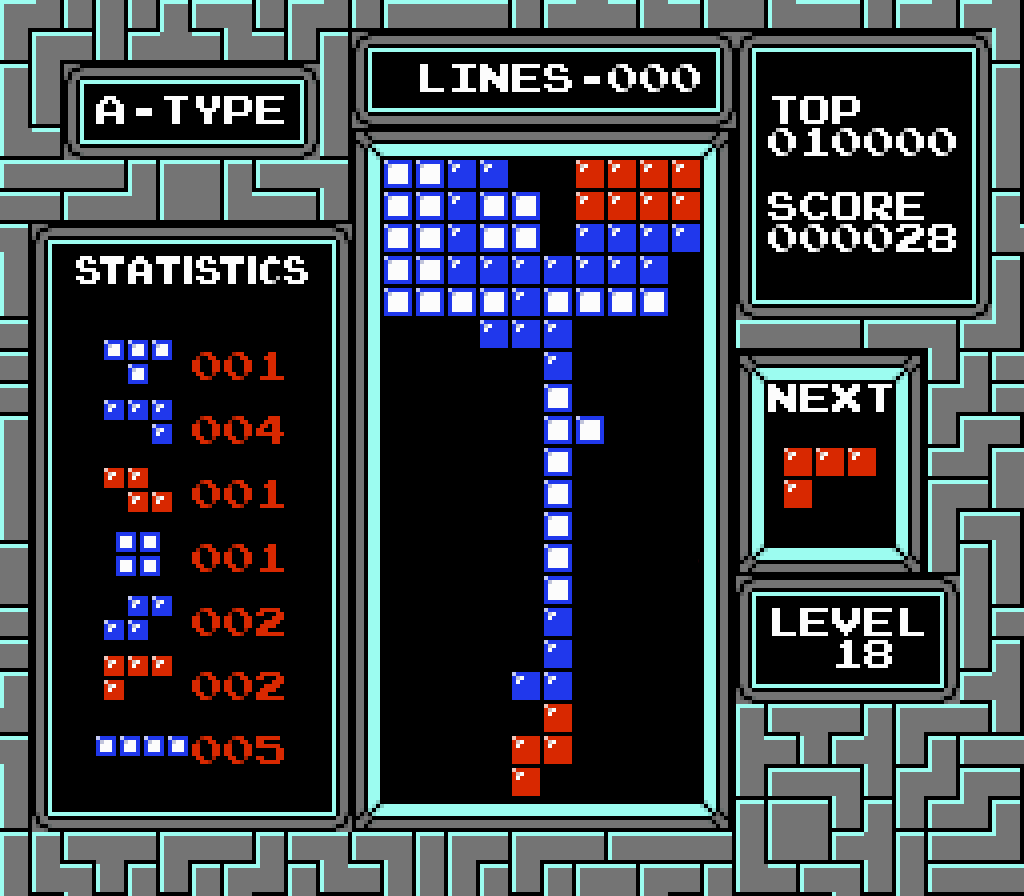 This shape uses 17 pieces in total. Acmlm used 18 pieces to reach his first tetris in published TAS. Estimated improvement about 25-30 frames.
"Tree#1" must have 15 blocks high and have 3 blocks flat top (it is T, L, or J tetraminos.) At the right branch two blocks at rightmost down corner must be empty. Last piece to burn tetris is L.
SRNG - Starting RNG
It is possible to try take extra advantage of using different starting RNG if to start at other frames. If find lucky starting RNG maybe some additional frames can be saved. Estimated improvement about 0-10 frames.
CH18/CH19 - Chessboard build
Instead of doing one long hole is better to build chessboard with knee after each 4 layers.
It allow burn faster becouse of long "I" tetramino will travel for shorter distance to ground.
This shape uses 17 pieces in total. Acmlm used 18 pieces to reach his first tetris in published TAS. Estimated improvement about 25-30 frames.
"Tree#1" must have 15 blocks high and have 3 blocks flat top (it is T, L, or J tetraminos.) At the right branch two blocks at rightmost down corner must be empty. Last piece to burn tetris is L.
SRNG - Starting RNG
It is possible to try take extra advantage of using different starting RNG if to start at other frames. If find lucky starting RNG maybe some additional frames can be saved. Estimated improvement about 0-10 frames.
CH18/CH19 - Chessboard build
Instead of doing one long hole is better to build chessboard with knee after each 4 layers.
It allow burn faster becouse of long "I" tetramino will travel for shorter distance to ground.
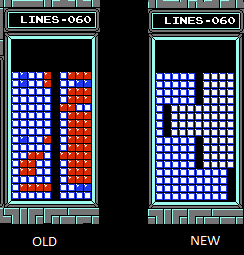 At level 18 speed "Chessboard build" can save 48 frames (8 + 16 + 24)
At level 19 speed "Chessboard build" can save 40 frames (7 + 13 + 20)
T3Skip - Tree#3 skip
Tree#3 can be skipped completely. It mean we need five full teramino less! So it will save about (25-30) * 5 = (125-150) frames.
To do so after transition we do not burn all field, instead of tree#3 is possible to use 12-lines ground.
At level 18 speed "Chessboard build" can save 48 frames (8 + 16 + 24)
At level 19 speed "Chessboard build" can save 40 frames (7 + 13 + 20)
T3Skip - Tree#3 skip
Tree#3 can be skipped completely. It mean we need five full teramino less! So it will save about (25-30) * 5 = (125-150) frames.
To do so after transition we do not burn all field, instead of tree#3 is possible to use 12-lines ground.
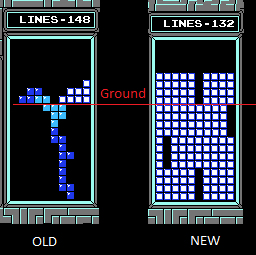 HBB - High Build Bonus
Additional betefit of skipping Tree #3 is that possible to continue building immidetely after transition. See picture above. I dont estimate how much it will save, lets say about 10-20 frames.
EM - Extra movement
There is a pausing trick that allow to move teetramino to one extra block futher than expected normally.
HBB - High Build Bonus
Additional betefit of skipping Tree #3 is that possible to continue building immidetely after transition. See picture above. I dont estimate how much it will save, lets say about 10-20 frames.
EM - Extra movement
There is a pausing trick that allow to move teetramino to one extra block futher than expected normally.
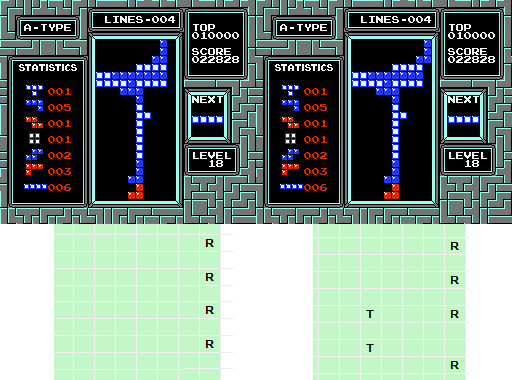 This trick not used in previous TAS. Not sure will it save something or not. But at least we have more freedom for build.
EIE - End imput earlier
End of imput can be done as soon as last "I" tetramino is rorated. Estimated improvement about 65 frames.
Well, it is not pure improvement it is more alternative ending timing method. After reaching 999999 points Acmlm also reached top of screen to finish game faster. But i disagree this this decision, in my opinion shortest input time is universal goal for all TAS. And so Tetris should not be an exception of this rule.
EP - Ending problems
Besides pros, my new strategy has one serious difficulty at the very end.
For perect ending we need 4 long pieces "I-I-I-I" in row at very end. It is extrimly difficult to achive.
This trick not used in previous TAS. Not sure will it save something or not. But at least we have more freedom for build.
EIE - End imput earlier
End of imput can be done as soon as last "I" tetramino is rorated. Estimated improvement about 65 frames.
Well, it is not pure improvement it is more alternative ending timing method. After reaching 999999 points Acmlm also reached top of screen to finish game faster. But i disagree this this decision, in my opinion shortest input time is universal goal for all TAS. And so Tetris should not be an exception of this rule.
EP - Ending problems
Besides pros, my new strategy has one serious difficulty at the very end.
For perect ending we need 4 long pieces "I-I-I-I" in row at very end. It is extrimly difficult to achive.
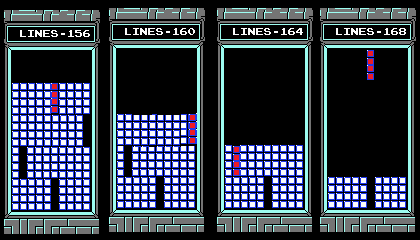 EP0 - I think if re-solve last segment many times sooner or later right RNG with 4 "I" at the end can be found.
For case if it would be impossible (or too long) to get 4 "I" there are two possibility:
EP1 - It possible to waste one piece like I-X-I-I-I or I-I-X-I-I or I-I-I-X-I
But i strongly not like idea of wasting piece. EP1-solution is not an option for good TAS.
EP2 - To avoid wasting piece there is alternative "smart end" by using incomplete upper tetris: it require only long pieces "I-I-I" in row.
For example like this. I-O-O-I-I-I. Or something similar. It slower than 4 "I" but 3 "I" seems more or less possible to achive.
Estimated worsening for EP1/2 about 25-50 frames.
Summary:
IMP = FT + SRNG + CH18 + T3Skip + HBB + CH19 + EM* + EIE - EP
(25-30) + (0-10) + 48 + (125-150) + (10-20) + 0* + 40 + 65 - (0/25-50) = 263-373 frames can be saved +/- something.
Playaround
I also think that would be nice to improve not only "fastest 999999" but also "playaround" and beat both remaining TASes at the same time.
To do so after completing "fastest 999999" with improvement we will dont stop here. No! Instead we start doing bonus "playaround" and play additional 2-3 minutes. For playaround my idea is to draw pixel art.
Pixelart1 -> Burn -> Pixelart2 -> Burn -> Pixelart3 -> Burn -> ...
Final product can be called "fastest 999999 + playaround" or simply "Mode A". But it too early to discuss. Since fastest 999999 is the hardest part.
EP0 - I think if re-solve last segment many times sooner or later right RNG with 4 "I" at the end can be found.
For case if it would be impossible (or too long) to get 4 "I" there are two possibility:
EP1 - It possible to waste one piece like I-X-I-I-I or I-I-X-I-I or I-I-I-X-I
But i strongly not like idea of wasting piece. EP1-solution is not an option for good TAS.
EP2 - To avoid wasting piece there is alternative "smart end" by using incomplete upper tetris: it require only long pieces "I-I-I" in row.
For example like this. I-O-O-I-I-I. Or something similar. It slower than 4 "I" but 3 "I" seems more or less possible to achive.
Estimated worsening for EP1/2 about 25-50 frames.
Summary:
IMP = FT + SRNG + CH18 + T3Skip + HBB + CH19 + EM* + EIE - EP
(25-30) + (0-10) + 48 + (125-150) + (10-20) + 0* + 40 + 65 - (0/25-50) = 263-373 frames can be saved +/- something.
Playaround
I also think that would be nice to improve not only "fastest 999999" but also "playaround" and beat both remaining TASes at the same time.
To do so after completing "fastest 999999" with improvement we will dont stop here. No! Instead we start doing bonus "playaround" and play additional 2-3 minutes. For playaround my idea is to draw pixel art.
Pixelart1 -> Burn -> Pixelart2 -> Burn -> Pixelart3 -> Burn -> ...
Final product can be called "fastest 999999 + playaround" or simply "Mode A". But it too early to discuss. Since fastest 999999 is the hardest part.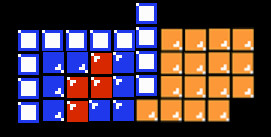
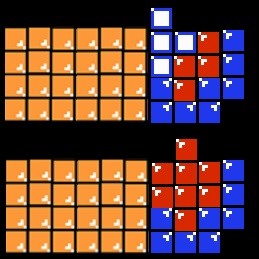
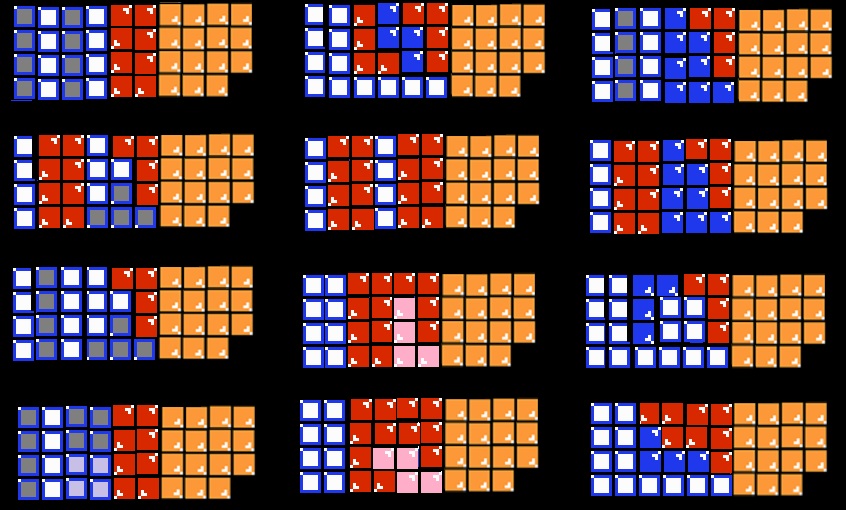
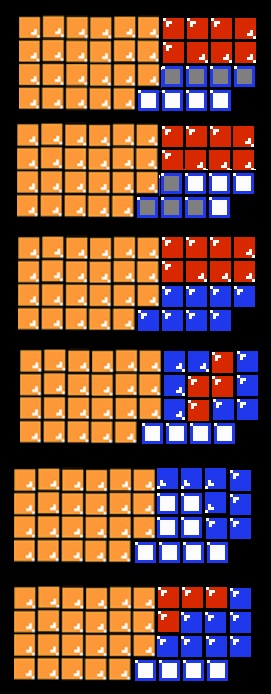
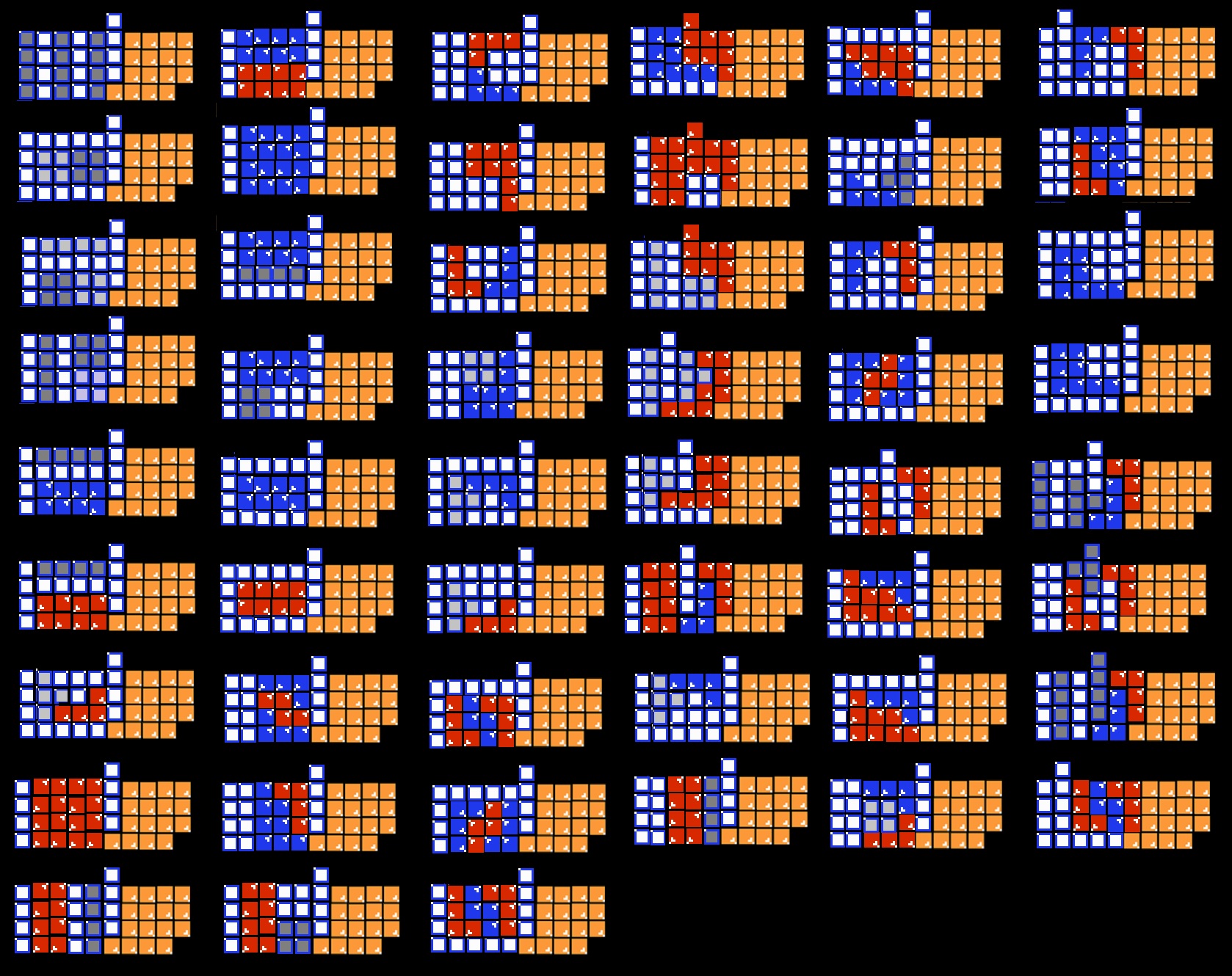
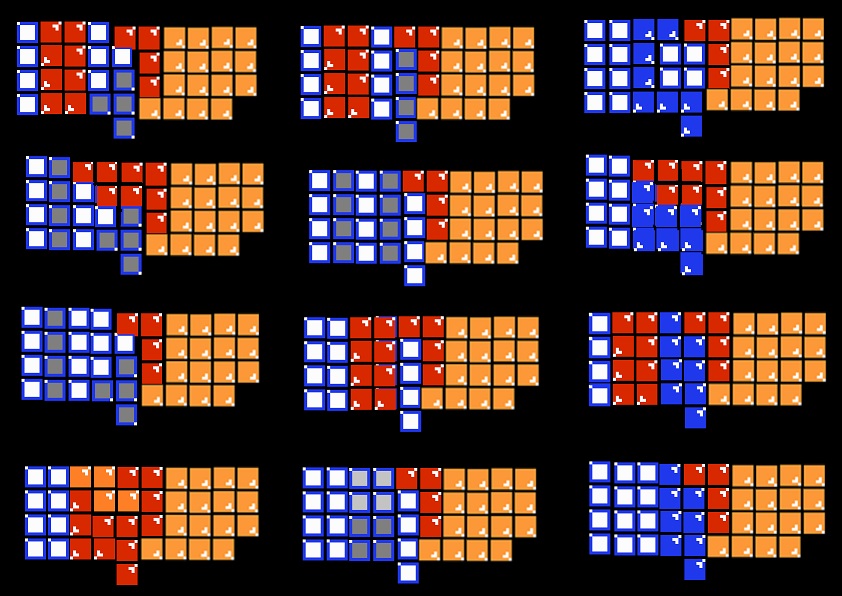
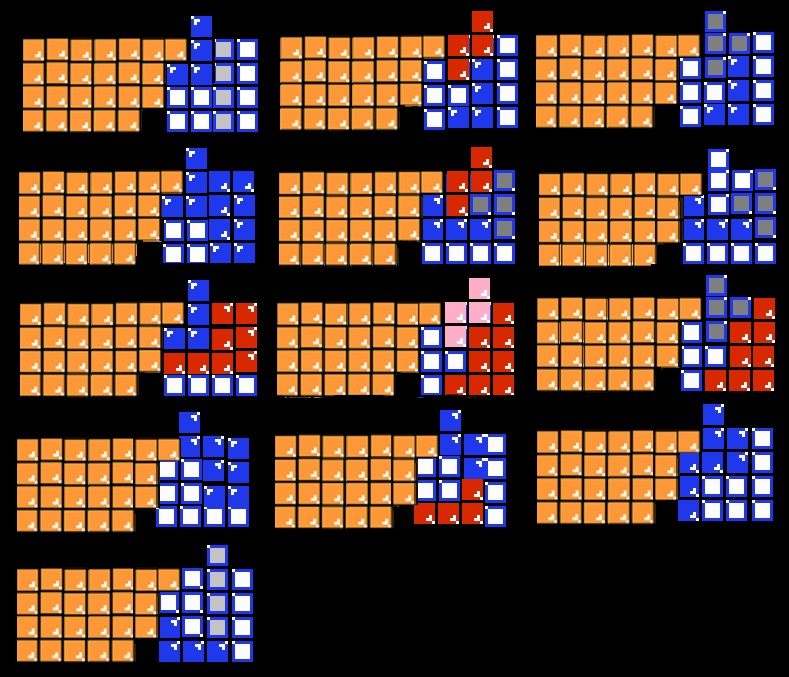
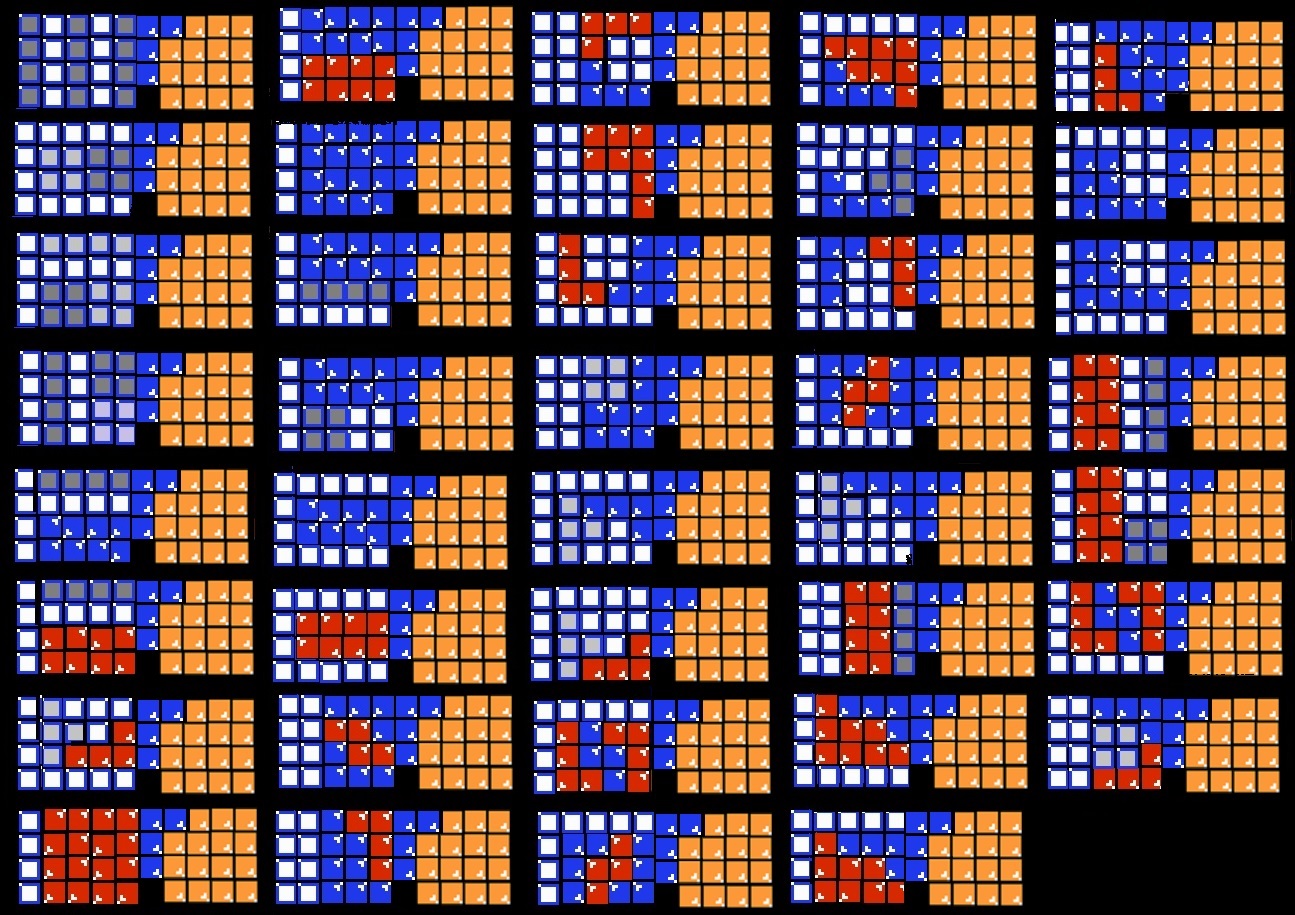
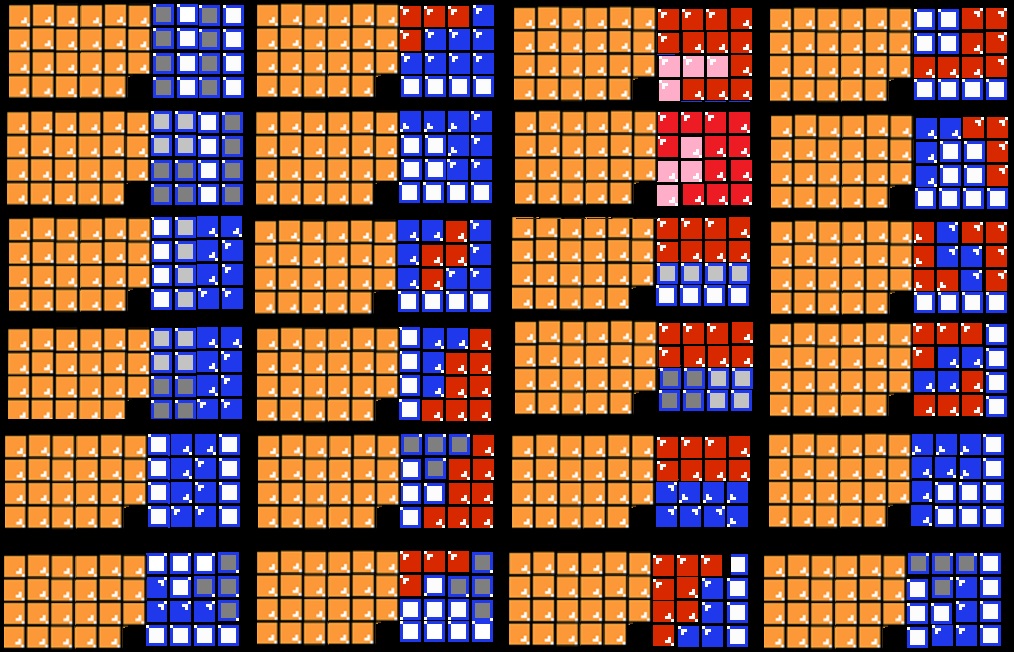

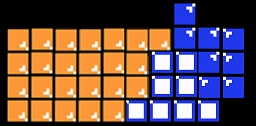
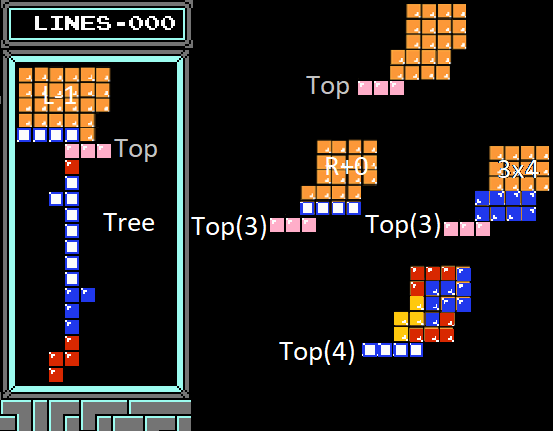 Right branch slightly more complexity.
First option for right branch can be also "I"-piece at bottom. In this case above need to build standart "
Right branch slightly more complexity.
First option for right branch can be also "I"-piece at bottom. In this case above need to build standart "